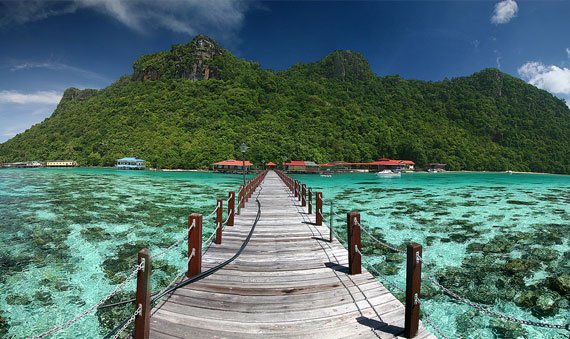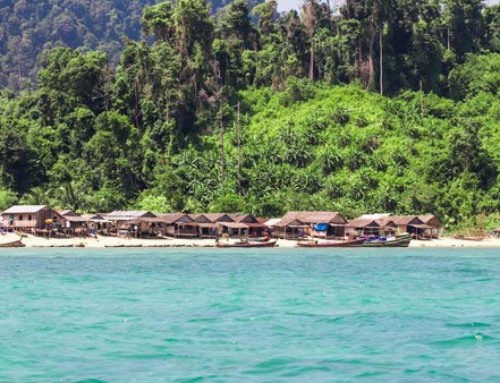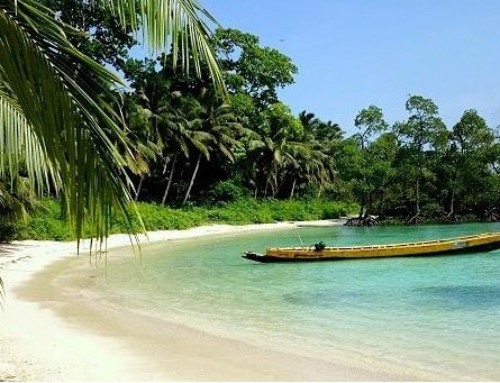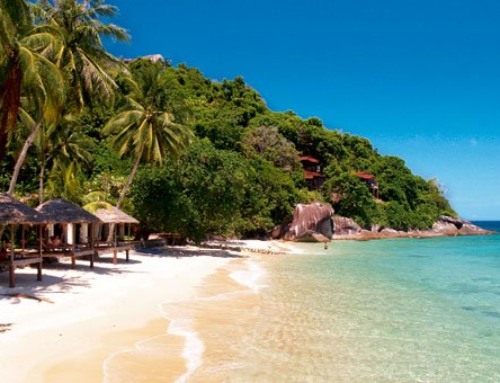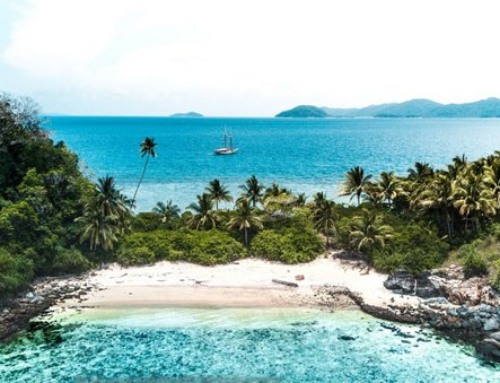BORNEO – SABAH MALAYSIA
Borneo is the largest non-continental island in the world divided between three countries: Brunei, Indonesia and Malaysia. The Malaysian north is made up of two states Sarawak and Sabah, with the Federal controlled island of Labuan in between.
Though suitable for year round cruising the best months to visit are between March and October and Schooner Dallinghoo will be available to charter here from the beginning of June to mid-October.
International airports are located both on the island of Labuan and the capital of Sabah, Kota Kinabalu known, affectionately as ‘KK’. Charter can start from either of these main hubs or from a number of smaller coastal towns which have regional airports serviced from KK.
Trips will be tailored to your desires with so much to offer;
For the divers we have offshore island and reefs with some of the finest diving in the world, WWII wreck litter the sea bed around the coast as these seas were heavily fought over with the British, American and Australian navies battling to retake the region for the Japanese.
For the natural lover there is equal amount of natural beauty above the water as there is below, excursions can be arranged to trek through the jungle, visit the Orangutan sanctuaries and the turtle conservation beaches. The diversity of the flora and fauna on Borneo is second to none.
SOUTH CHINA SEA COAST
 Kota Kinabalu (KK ) is a modern city and the capital of Sabah with a population for 650,000 and growing. There are marinas and golf courses and a number of shopping malls, local markets and a good array of tourist shops. The ‘waterfront’ has been transformed recently into a trendy night area with bars and restaurants popular with the tourists and locals alike. There are a number of great islands and beaches just off the coast making up the Tunku Abdul Rahman national park including Pulau Gaya, Pulau Manukan, Pulau Mamutik and Pulau Sulug, all of these islands that can be used for day trips returning to KK for the evening in town. Overlooking the town is Mount Kinabalu, the tallest mountain in South East Asia however a peak that can be walked up – be it by the young and fit. Guided tours leave the base in the early hours of the morning with the plan to reach the peak to watch the sun rise over Borneo – quite a spectacular experience for those who take the challenge on.
Kota Kinabalu (KK ) is a modern city and the capital of Sabah with a population for 650,000 and growing. There are marinas and golf courses and a number of shopping malls, local markets and a good array of tourist shops. The ‘waterfront’ has been transformed recently into a trendy night area with bars and restaurants popular with the tourists and locals alike. There are a number of great islands and beaches just off the coast making up the Tunku Abdul Rahman national park including Pulau Gaya, Pulau Manukan, Pulau Mamutik and Pulau Sulug, all of these islands that can be used for day trips returning to KK for the evening in town. Overlooking the town is Mount Kinabalu, the tallest mountain in South East Asia however a peak that can be walked up – be it by the young and fit. Guided tours leave the base in the early hours of the morning with the plan to reach the peak to watch the sun rise over Borneo – quite a spectacular experience for those who take the challenge on.
 Labuan is a duty free island and Offshore Financial Centre, it is often used as a weekend destination for those living in the conservative Brunei to let down their hair. It has beaches and hotels along with a number of bars and night clubs however along with the centre for R&R it also has an number of interesting place to see. The peace park is built on the site that the Japanese army surrendered to the allied forces at the end of WWII, there is also the Commonwealth War Cemetery, kept in immaculate condition and where on Remembrance Sunday every November there is a wonderful service. A tour of the island would not be complete without a stop at the bird park, the famous cChimney and the Botanical Gardens Just of the shore are some small islands for day trips and to anchor overnight and here there are some great wreck dives to be had in the 20 to 30m depth range. Labuan can be used as either an embarkation point or for dis-embarkation, for a short stay or for a longer stay. There is a modern marina at the ‘Waterfront Hotel’ where berthing can be arranged.
Labuan is a duty free island and Offshore Financial Centre, it is often used as a weekend destination for those living in the conservative Brunei to let down their hair. It has beaches and hotels along with a number of bars and night clubs however along with the centre for R&R it also has an number of interesting place to see. The peace park is built on the site that the Japanese army surrendered to the allied forces at the end of WWII, there is also the Commonwealth War Cemetery, kept in immaculate condition and where on Remembrance Sunday every November there is a wonderful service. A tour of the island would not be complete without a stop at the bird park, the famous cChimney and the Botanical Gardens Just of the shore are some small islands for day trips and to anchor overnight and here there are some great wreck dives to be had in the 20 to 30m depth range. Labuan can be used as either an embarkation point or for dis-embarkation, for a short stay or for a longer stay. There is a modern marina at the ‘Waterfront Hotel’ where berthing can be arranged.
 Brunei – the small independent oil rich state of Brunei lies just across the bay from Labuan, we can include Brunei into an itinerary of the northern coast of Sabah. Schooner Dallinghoo can anchor off the yacht club at Muara and excursions arranged to the interior. Visits to the capital Bandar Seri Begawan are a short distance away and also has an international airport. Brunei still has much of it’s virgin primary rain-forest and eco tours are popular. There is also a modern fun-fair and plenty of food markets for the night out. Being a conservative Muslim country, alcohol is prohibited and a dress code has to be followed.
Brunei – the small independent oil rich state of Brunei lies just across the bay from Labuan, we can include Brunei into an itinerary of the northern coast of Sabah. Schooner Dallinghoo can anchor off the yacht club at Muara and excursions arranged to the interior. Visits to the capital Bandar Seri Begawan are a short distance away and also has an international airport. Brunei still has much of it’s virgin primary rain-forest and eco tours are popular. There is also a modern fun-fair and plenty of food markets for the night out. Being a conservative Muslim country, alcohol is prohibited and a dress code has to be followed.
Pulua Tiga (National Park) – A small island between Labuan and KK, this was first made ‘famous’ by the staging and filming of the first ever ‘survivor’ series and is now commonly known as Survivor Island. It now has a small ecofriendly resort on it and has visitors coming out from KK to see the island and the natural beauty of the place. There are warm mud baths to dip into with allegedly therapeutic properties, the reeds around the island have some excellent snorkeling and diving on some of the outer islets is good.
 Pulau Layan Layan (Swallow Reef) can be visited by Schooner Dallinghoo, this is a single island with a reef lagoon some way off the coast of Sabah in the South China Sea, it’s isolated position and the depth of the surrounding waters makes this an amazing reef dive location and is famous for the shoals of Hammerhead Sharks that can be seen here at certain times of the year – don’t worry if the sharks are not here the diving is still amazing! Dives can be had in the shallow lagoon or on the outter reefs with their ‘drop offs’. Schooner Dallinghoo can enter the reef lagoon and pick up a mooring buoy, and there is a luxury resort on the island.
Pulau Layan Layan (Swallow Reef) can be visited by Schooner Dallinghoo, this is a single island with a reef lagoon some way off the coast of Sabah in the South China Sea, it’s isolated position and the depth of the surrounding waters makes this an amazing reef dive location and is famous for the shoals of Hammerhead Sharks that can be seen here at certain times of the year – don’t worry if the sharks are not here the diving is still amazing! Dives can be had in the shallow lagoon or on the outter reefs with their ‘drop offs’. Schooner Dallinghoo can enter the reef lagoon and pick up a mooring buoy, and there is a luxury resort on the island.
Pulau Manglum and Pulau Mantanani are both small island along the northern coat of Sabah and offer great snorkeling and diving opportunities and are both located in suitable areas for a stop over on the route from KK to Kudat in the north. The Mantanani islands are a group of three small islands located in the South China Sea, 35km north of Kota Belud (Sabah). Pulau Mantanani Besar is the biggest of these three islands, extending 3.5km from east to west and 800m from north to south. It has beautiful white coral sand beaches and is surrounded by crystal clear sea. It is possible to walk once around the island in about two hours, for instance by starting at the Mari Mari resort and proceeding counterclockwise, then crossing the island through the forest once reaching the end of the northern beach.
Kudat is a small but very busy ‘border’ town and with a bustling port for the shipping back and forth to the Philippines. Though not offering too much of interest to tourists it isd the place to clear in and out off on the trips to the Philippines and a good place to provision and a staging post for trips to the northern islands. Kudat has an airport with regular flights to KK and the road connection is good and KK can be reached in 3 to 4 hours, thus making Kudat a very good embarkation point for trips to the north.
 Northern Islands Group – This island group is just a short trip from Kudat and consists of two large islands Pulau Banggi and Pulau Balambangan and numerous smaller islands, many are uninhabited and cruising here and only be described as ‘off the beaten track’. Pulau Banggi is however the largest island in Malaysia and has a small town on it and it’s own indigenes tribe and own dialect spoken.
Northern Islands Group – This island group is just a short trip from Kudat and consists of two large islands Pulau Banggi and Pulau Balambangan and numerous smaller islands, many are uninhabited and cruising here and only be described as ‘off the beaten track’. Pulau Banggi is however the largest island in Malaysia and has a small town on it and it’s own indigenes tribe and own dialect spoken.
The Sulu Sea and the Celebes Sea Continuing along the Sabah coast from the Kudat you enter the Sulu Sea running from Kudat to Sandakan and then from Sandakan to Tawau on the Malaysian /Indonesian boarder you are in the Celebes Sea. All along the coast line to both these seas there are numerous islands and coral reefs, much of the sea area is uncharted. The coast line has three principle towns, none are particular special however all offer interesting excursion opportunities ashore and are good locations to embark or dis-embark Schooner Dallinghoo.
Sandakan was founded in the 1870s as a trading outpost, grew during the timber boom to become the largest city in Sabah and became the capital of former British North Borneo. It was completely destroyed in WW II it was rebuilt and is nowadays the second largest city in Sabah. Sandakan itself has no particular tourist attractions but is a good base from which to explore the surrounding area and to access the nearby tourist attractions: the Sepilok Orang Utan rehabilitation centre, Labuk bay, the Turtle islands park and the Kinabatangan river wildlife conservation area.
 Semporna is a small town between Sandakan and Tawau. Semporna was founded in the 19th century by the British and is nowadays populated mainly by Bajaus, people who originally came from the Philippines. Tourists in Sempora are generally passing through to reach the Islands offshore, these include among others Sibuan, Mabul and Sipadan, world-famous for its fine diving sites.
Semporna is a small town between Sandakan and Tawau. Semporna was founded in the 19th century by the British and is nowadays populated mainly by Bajaus, people who originally came from the Philippines. Tourists in Sempora are generally passing through to reach the Islands offshore, these include among others Sibuan, Mabul and Sipadan, world-famous for its fine diving sites.
Tawau is a city on the southern coast of Sabah, very close to the border to Indonesia. It dates back to the 1890s, when the area was first settled, and quickly developed into a centre for the export of agricultural products of the region. Nowadays Tawau is the world’s third largest producer of cocoa after the Ivory Coast and Ghana. While Tawau is a pleasant town and has a large number of hotels and restaurants, it does not offer much in term of tourist attractions. Most notable is the Al-Kauthar mosque, completed in 2004. The airport of Tawau, which has direct connections to KL, is the closest airport to Semporna and the Malaysian Celebes sea islands.
ISLANDS OF THE SULU & CELEBES SEA
 Pulau Berhals is a rocky island opposite to Sandakan (Sabah, Malaysia), extending for about 4km from north to south. At its southern end there are high sandstone cliffs, falling straight into the sea in some spots. On its eastern side there are two beaches, a shorter one close to the southern end and a longer one close to the northern end. Both beaches are deserted, i.e. have no tourist infrastructure. Close to the northern tip, on the western side there is a village consisting of houses and stilt houses inhabited by local Malaysians. The main attraction of Berhala are its cliffs which offer good climbing opportunities (direct start from the ebach is possible). In any case at the moment there is no tourist infrastructure at all on the island and to get there it is necessary to charter a boat from Sandakan. There are also fishermen boats but these only make it to the village on the western side of Berhala.
Pulau Berhals is a rocky island opposite to Sandakan (Sabah, Malaysia), extending for about 4km from north to south. At its southern end there are high sandstone cliffs, falling straight into the sea in some spots. On its eastern side there are two beaches, a shorter one close to the southern end and a longer one close to the northern end. Both beaches are deserted, i.e. have no tourist infrastructure. Close to the northern tip, on the western side there is a village consisting of houses and stilt houses inhabited by local Malaysians. The main attraction of Berhala are its cliffs which offer good climbing opportunities (direct start from the ebach is possible). In any case at the moment there is no tourist infrastructure at all on the island and to get there it is necessary to charter a boat from Sandakan. There are also fishermen boats but these only make it to the village on the western side of Berhala.
 Pulau Sibuan is a beautiful island in the Celebes sea, about 45 minutes by boat from Semporna. Long and narrow, it has a triangular shape if viewed from above. At the southern end there is a long narrow strip of sand, which gets flooded at high tide. In the center of the island there is a small forest and the beaches are lined with coconut trees. On the island there is a small village of sea gipsies. The beaches are all beautiful and consist of (almost) white coral sand.
Pulau Sibuan is a beautiful island in the Celebes sea, about 45 minutes by boat from Semporna. Long and narrow, it has a triangular shape if viewed from above. At the southern end there is a long narrow strip of sand, which gets flooded at high tide. In the center of the island there is a small forest and the beaches are lined with coconut trees. On the island there is a small village of sea gipsies. The beaches are all beautiful and consist of (almost) white coral sand.
Pulau Maiga is a small island in the Tun Sakaran Marine Park, located 16km north of Semporna. It is a flat sandy cay, measuring 800 meters from north to south and 300 meters at its widest. The maximum elevation probably is 1-2 meters. Maiga is covered by some coconut palms and has nice beaches. At the southern tip and along the west coast there is a settlement of Bajau (Sea Gypsy) from the Sulu sea. There are no water sources on the island, so probably the inhabitants get the water they need from the nearby Bodgaya island.
 Pulua Bodgaya is one of the larger islands of the Tun Sakaran Marine Park. It is located about 20km northeast of Semporna in the Sulu sea and consists of a mountainous arch spreading 7km from southwest to northeast. Bodgaya doesn’t have beaches worth visiting however it offers good anchorages and amazing views – this is Malaysia’s Bora-Bora! . Bodgaya is of volcanic origin.
Pulua Bodgaya is one of the larger islands of the Tun Sakaran Marine Park. It is located about 20km northeast of Semporna in the Sulu sea and consists of a mountainous arch spreading 7km from southwest to northeast. Bodgaya doesn’t have beaches worth visiting however it offers good anchorages and amazing views – this is Malaysia’s Bora-Bora! . Bodgaya is of volcanic origin.
Sepilok is a rehabilitation centre for orangutans near Sandakan in Sabah. Orphaned young orangutans are brought to the centre, where they are prepared for a life in the wild. The Sepilok centre enables visitors to come in close contact with the remarkable “man of the forest” (this is what the Malay name means) and witness an exciting conservation programme in action. Only 25 kilometres from Sandakan, and set in 43 square kilometres of beautiful virgin rainforest, the sanctuary was begun in 1964 to help once captive orang utan learn to fend for themselves in the wild. The great thing about Sepilok is that you are absolutely guaranteed to see Orang Utans, some even at very close range. Other species of monkeys also live there. In the park there are several very interesting forest trails.
Mataking is a tropical island lying off the coast of southern Sabah, 38km to the northeast of Semporna. Pulau Mataking consists of two islands, a big one (Mataking Besar), 1.4km long, and a small one (Mataking Kecil), just 400m long. At its widest point Mataking Besar is just 300m wide. On Mataking there is an expensive, high-end resort which caters mostly for divers. Mataking is covered by dense vegetation but there are no coconut palms along the beaches, except for a few ones near the resort bungalows which probably have been planted by the resort. Mataking is beautiful and offers stunning views, especially at high tide when staying on the sandbar. The waters surrounding Mataking are rich in marine wildlife. It is easy to spot sea turtles.
 Bohey Dulang is located 23km northwest of Semporna in the Sulu sea, within the Tun Sakaran Marine Park. Bohey Dulang is of volcanic origin and is mostly mountaineous. It is surrounded by a coral reef and crystal clear seawaters. It has beaches on its western and eastern sides, on the western side of the island there is a jetty which leads to some buildings dedicated to marine biology research. A small path leads to a viewpoint on top of the island (about 200m above the sea level) with nice views of the nearby islands. Together with Bodgaya, Bohey Dulang probably is what is left of the rim of a collapsed volcano.
Bohey Dulang is located 23km northwest of Semporna in the Sulu sea, within the Tun Sakaran Marine Park. Bohey Dulang is of volcanic origin and is mostly mountaineous. It is surrounded by a coral reef and crystal clear seawaters. It has beaches on its western and eastern sides, on the western side of the island there is a jetty which leads to some buildings dedicated to marine biology research. A small path leads to a viewpoint on top of the island (about 200m above the sea level) with nice views of the nearby islands. Together with Bodgaya, Bohey Dulang probably is what is left of the rim of a collapsed volcano.
Pom Pom is a small island in the Celebes sea, located 30km east of Semporna. Pom Pom is relatively flat, measures 600m x 900m, is bordered by white sand beaches and is surrounded by crystal clear sea waters. There is a big high-end resort with its own dive centre. The beaches on Pom Pom are very nice, but the seawater is quite shallow. For schedule and suggested itineraries click here
GETTING THERE
Joining Schooner Dallinghoo for a Borneo adventure would mean flying in to either KK or Labuan though it is also possible to join in Brunei.
 Pulau Redang
Pulau Redang
During the high season May to October regular flights are available direct to Redang. Redang Airport is a small airport with services operated by Berjaya Air from Singapore (Changi Airport) and Kuala Lumpur (Sultan Abdul Aziz Shah Airport).
You can also fly to Kuala Terengganu’s airport called Sultan Mahmud Airport (IATA: TGG, ICAO: WMKN) serving domestic and international routes is located 8 km (5.0 mi) from the city centre, in Seberang Takir, Kuala Nerus. The airlines serving this airport are Malaysia Airlines, Firefly, AirAsia, Malindo Air, and Sriwijya Air. If flying in to Terengganu you will need to catch the ferry services to Pulau Redang, these services are mainly carried out by modern express ferries. The ferries dock at Syahbandar Jetty, just in front of the General Post Office. It is also possible to arrange private ‘resort’ boats to taxi you across to Redang. Kuala Terengganu can also be reach by road and there are regular bus services from Malaysia Capital Kualala Lumpur, then as with flying Redang is only a short boat ride away.
 Pulau Tioman
Pulau Tioman
Tioman Airport (IATA: TOD, ICAO: WMBT), also known as Pulau Tioman Airport, it is located next to Tekek village (Kampung Tekek). The main village on the island and is also the location of the marnina and ferry port. Flights are by propeller plane service by Berjaya Air from the Changi Airport in Singapore and Sultan Abdul Aziz Shah Airport in Kuala Lumpur.
Tioman island is served by ferries from the Malaysian mainland from the town of Mersing where there are good road links to both Singapore and Kuala Lumpur. Mersing port in the mouth of Mersing River is the main port for ferries to Pulau Tioman and the more than 40 other islands in the Seribuat Archipelago. Mersing town lies on the main trunk road that connects south to Singapore as well as west to Kuala Lumpur

